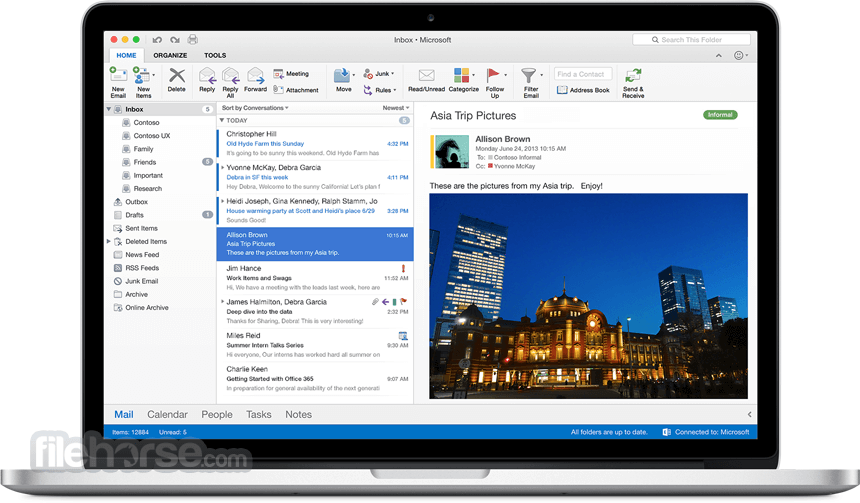
- #OUTLOOK FOR MAC 2016 OFFICE365 FOR MAC#
- #OUTLOOK FOR MAC 2016 OFFICE365 INSTALL#
- #OUTLOOK FOR MAC 2016 OFFICE365 UPDATE#
- #OUTLOOK FOR MAC 2016 OFFICE365 ARCHIVE#
#OUTLOOK FOR MAC 2016 OFFICE365 FOR MAC#
All these information are helpful for users if they are going to continue working on Mac Operating System environment and using Outlook for Mac email client.įor any reason, if user thinks to move to Windows Operating System environment, then we have a reliable way to move precious OLM file data to this new environment.

Till now, we have learnt the significance of OLM file in Outlook for Mac, default locations of OLM files for different versions on Mac system, process to backup emails in OLM file and importing backup OLM file to a new or updated Outlook for Mac version. After importing the data, you can access them into your account.
#OUTLOOK FOR MAC 2016 OFFICE365 ARCHIVE#
Select the third-option of Outlook for Mac archive file (OLM).Ĭlick Continue and browse the OLM file to import it.In the Tools category, click the Import option.Then you can easily import the OLM files to Outlook using the same procedure. If you have upgraded from Outlook 2011 to Outlook 2016 or from Outlook 2016 to Outlook 2019. Outlook starts to Export the data to the OLM file.Īfter saving the OLM files at any location, you can later use them to import to an updated version of Outlook.Provide a name to the OLM file and browse the saving location.You can shuffle between multiple types and categories. Select the data based on type and category.


#OUTLOOK FOR MAC 2016 OFFICE365 INSTALL#
The AutoUpdate app will download and install the latest updates. Here, you choose the option ‘check for updates,’ and it will launch the AutoUpdate app. Open the Outlook for Mac application and go to Help Menu.
#OUTLOOK FOR MAC 2016 OFFICE365 UPDATE#
When you are accessing or restoring the Library folder, then you should be aware of installing the latest update to keep the Outlook for Mac updated with the latest modifications. When you select the GO option from the FILE MENU, then hold-down the OPTION key, and it will show the Library folder. Users/‹username›/Library/Group Containers/UBF8T346G9.Office/Outlook/Outlook 15 Profiles/Main Profileīy default, the ‘Outlook 15 Profiles’ folder remains hidden you need to make it visible to get the OLM file. Users/‹username›/Documents/Microsoft User Data/Office 2011 Identities/Main Identity You won't be able to move folders but can move all the messages in a folder at once.Ĭheck the box next to all the messages you want to archive.ĭrag them to the folder in the navigation pane labeled Personal Archive. If you want to archive multiple messages at one time, and no archive or retention policies are in place, use Outlook Web App to move the messages from your primary mailbox to the archive. See Retention and archive policies in Outlook Web App for instructions.

Although admins set policies for the entire organization, you can override the policies to suit your needs. Archive policies control how long messages are left in an email folder before they're moved to an archive retention policies control how long your messages will be saved. Best practices for moving your mail to the archiveĪlthough you can move individual messages from Outlook for Mac to your archive mailbox one by one (you can't move or copy multiple items at once), the more efficient way to make sure your messages get archived is to use Outlook Web App archive and retention policies.Īrchive and retention policies are set by your IT or Microsoft 365 administrator. Talk to your IT or Microsoft 365 admin about co-locating them. If your primary mailbox is in on Exchange Server, for example, and your archive account is in Exchange Online in Microsoft 365, you won't be able to use your online archive. Note: In order for your archive mailbox to work with Outlook for Mac both your archive and primary mailboxes must be either on an Exchange Server (on-premises) or on Exchange Online in Microsoft 365 (cloud).


 0 kommentar(er)
0 kommentar(er)
